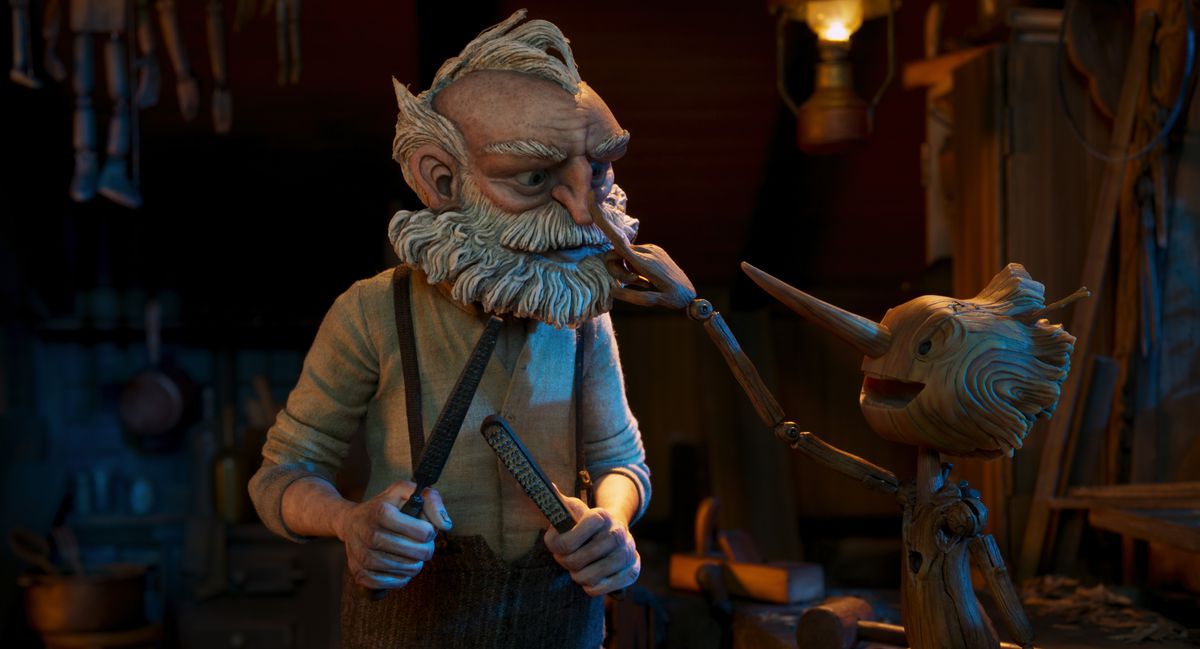At a press event for Netflix’s upcoming movie Guillermo del Toro’s Pinocchio in London this week, I got to hold Pinocchio’s hand. In fact, I held all of him. While Pan’s Labyrinth and The Shape of Water director Guillermo del Toro took questions, the puppets for the wooden boy Pinocchio and his father and creator, Geppetto, were passed around the room, and the audience was encouraged to handle and manipulate them.
They were smaller than I expected: Geppetto stands about a foot tall, while Pinocchio was maybe 8 inches. Pinocchio is quite light, Geppetto surprisingly heavy. They’re extraordinarily detailed puppets, and handlers can move not just their joints and digits, but their facial features. I adjusted Geppetto’s eyebrows to make him look suspicious, then surprised. I feared the puppets would be delicate, but they were sturdy and easy to manipulate. It was a wonderfully tactile, personal experience.
This, del Toro said, is why he chose stop-motion animation for his version of Pinocchio, unlike the recent Disney live-action remake, which went with an all-CG lead character. Del Toro’s team, led by co-director Mark Gustafson, fought hard to avoid any kind of digital shortcut that might soften the look, or break the bond between animator and puppet.
Del Toro particularly insisted that the team use “head mechanics” — a system of tiny levers, cogs, and gears inside the puppets’ heads — to animate the puppets’ facial expressions, rather than digital replacement. Tiny screwdriver holes in the puppets’ heads operate the mouths, eyes, and other features.
“I wanted to return the controls of animation to the animators, and treat [the animators] as actors,” del Toro said. He encouraged his team to make “failed acts” — the tiny stumbles and imperfections that make a performance by a live actor feel real — and resist what he called the “codification of animation into a ‘cool’ language that is almost like emojis.” (A particularly egregious example of this might be the DreamWorks Face.)
“Stop-motion has been a lost art since it started,” del Toro said. “Stop-motion is absolutely the most incredibly, exhaustively demanding animation, you know, and it’s only done by a group of complete and utter strange people that sustain it, time and time again. The reason is the bond between the puppet and the animator is so incredibly beautiful and sacred.
“It reminds me of a Japanese art called bunraku, which is an actor in black garb [who] puts a puppet in front, and manipulates it with his own limbs. And they play against a black background, and the puppet only becomes alive through the life of the puppeteer. And this is something that you can see here.”

Image: Netflix
Del Toro didn’t just want to resist CG — he’s fighting the urge to make stop-motion too perfect. “Stop-motion animation — there’s no good or bad, but as of lately, the last 20 years, it has moved to a point, technically and philosophically, when it was almost indistinguishable from CG animation. And we wanted the immediacy of a set that, you know, was carved and sculpted, aged in a way that was manually done.”
Del Toro said the film’s animation supervisor, Brian Leif Hansen, “ferociously fought for anything we could do, even if it was silly and impractical, to be done in stop-motion. And only when he needed to give up would he give up.” Small items like popcorn or ashes would be shot practically, held by tiny wires that would then be erased digitally; fire, water and snow were created with practical materials that were then scaled and replicated digitally. The most difficult thing to pull off was the ocean, del Toro said. Here, the team resorted to digital effects, but still tried to make it look like like it was made in stop-motion: “like a cross between a real ocean and a gelatin ocean.”
Going by the preview of the film we were shown, del Toro’s team (split between three studios in Portland, Oregon; Manchester, U.K.; and Guadalajara, Mexico) has created a remarkably textured and expressive piece of movie animation. Pinocchio premieres at the London Film Festival on Oct. 15, and we’ll post a review for you soon after. The film debuts on Netflix on Dec. 9.

